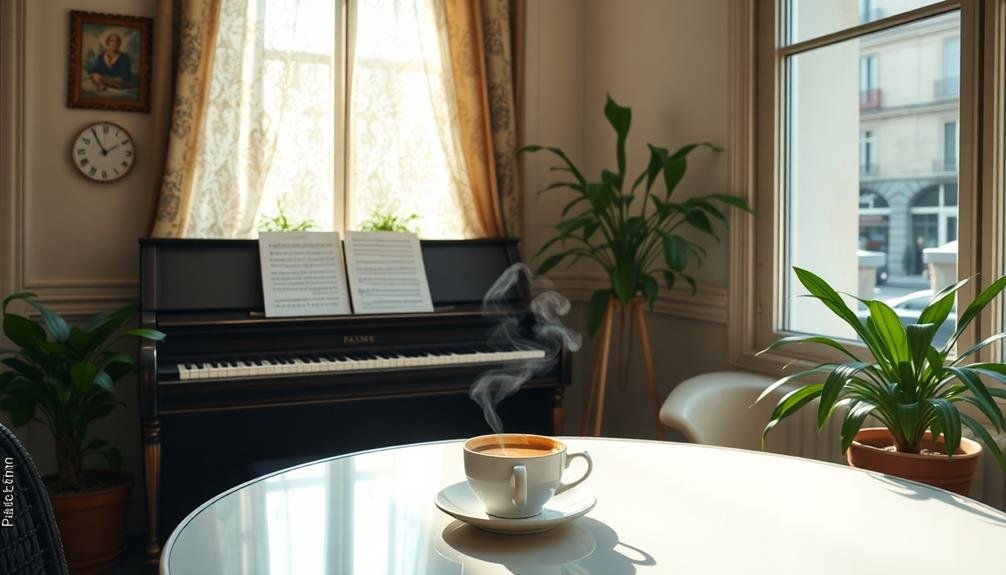Looking to calm your restless mind? These gentle piano melodies can help. Beethoven's "Moonlight Sonata" offers a melancholic embrace, while Yiruma's "River Flows in You" evokes tranquil waters. Debussy's "Clair de Lune" takes you on a mesmerizing moonlit journey. Michael Nyman's "The Heart Asks Pleasure First" stirs deep emotions, and Satie's "Gymnopédie No. 1" promotes introspection. Einaudi's "Nuvole Bianche" mimics serene skies, and Pachelbel's "Canon in D Major" soothes with repeating patterns. Michael Jones's "Time's Gentle Passage" reflects on life's cycles, while Einaudi's "Una Mattina" captures a peaceful dawn. Discover how these timeless compositions can transport you to a state of blissful tranquility.
Moonlight Sonata's Soothing Embrace

One of the most beloved piano pieces ever composed, Beethoven's "Moonlight Sonata" wraps listeners in a gentle, melancholic embrace. As you listen, you'll find yourself transported to a world of quiet contemplation and emotional depth. The piece's slow tempo and minor key create a somber atmosphere, while the rolling arpeggios mimic the soft shimmer of moonlight on water.
The first movement, Adagio sostenuto, is the most famous and recognizable. Its haunting melody floats above a steady, rippling accompaniment, creating a hypnotic effect that can ease your restless mind. You'll notice how the piece builds and recedes like gentle waves, never becoming overwhelming or jarring.
As you immerse yourself in the "Moonlight Sonata," you may find your breathing slowing and your muscles relaxing. The piece's subtle dynamics and rich harmonies encourage introspection and can help quiet racing thoughts.
Whether you're seeking solace after a long day or simply want to experience the beauty of Beethoven's genius, this timeless composition offers a soothing musical journey that continues to captivate listeners more than two centuries after its creation.
River Flows in You
You'll find yourself captivated by Yiruma's emotional masterpiece, "River Flows in You."
This gentle piano melody evokes a sense of tranquility with its rippling effects, reminiscent of water flowing over smooth stones.
As you listen, you'll experience the calming power of this beautifully crafted composition, allowing it to wash away your stress and worries.
Yiruma's Emotional Masterpiece
Cascading notes like gentle raindrops form the iconic opening of Yiruma's "River Flows in You." This South Korean pianist and composer created a modern classical masterpiece that resonates with listeners worldwide.
As you listen, you'll notice the piece's simple yet evocative melody. It's built on a repeating pattern that grows in complexity, mirroring the ebb and flow of a river. Yiruma's delicate touch on the keys creates a sense of intimacy, as if he's playing just for you.
The song's emotional power lies in its ability to evoke various feelings. You might find yourself swept away by its melancholic undertones or uplifted by its hopeful progression. It's this versatility that has made "River Flows in You" a popular choice for weddings, film soundtracks, and personal playlists.
Yiruma's composition technique shines through in the piece's structure. He skillfully balances repetition with subtle variations, keeping you engaged throughout.
The song's gentle dynamics and soothing rhythm make it perfect for relaxation, meditation, or simply unwinding after a long day.
Calming Rippling Effects
As you listen to "River Flows in You," you'll notice the calming rippling effect created by Yiruma's precise fingering technique. The gentle, flowing arpeggios mimic the movement of water, creating a soothing atmosphere that can help ease your restless mind.
The piece begins with a simple, repeating pattern in the right hand, establishing a tranquil mood. As the melody unfolds, you'll hear subtle variations that add depth and emotion to the composition. Yiruma's use of dynamics enhances the rippling effect, with softer notes representing gentle currents and louder passages evoking stronger flows.
You'll find yourself drawn into the piece's hypnotic rhythm, feeling your tension melt away as the music washes over you. The left hand provides a steady, grounding bass line that anchors the floating melody, creating a sense of balance and stability.
As you immerse yourself in the music, you may notice how the rippling effect extends beyond just the sound. Your thoughts might begin to flow more freely, and your breathing may naturally sync with the piece's gentle rhythm, further enhancing its calming effects.
Clair De Lune's Tranquil Journey

Claude Debussy's "Clair de Lune" takes listeners on a mesmerizing journey through tranquil moonlit landscapes. As you immerse yourself in this masterpiece, you'll feel the gentle ebb and flow of its melody, mirroring the subtle shimmer of moonlight on a calm lake. The piece's delicate phrasing and nuanced dynamics transport you to a serene, dreamlike state.
You'll notice how Debussy expertly crafts tension and release throughout the composition. The opening notes softly introduce the theme, gradually building to a crescendo that washes over you like a warm, comforting wave. As the piece progresses, you'll experience moments of introspection and wonder, punctuated by brief, sparkling runs that evoke images of twinkling stars.
The harmonic structure of "Clair de Lune" contributes markedly to its soothing effect. Debussy's use of whole-tone scales and unconventional chord progressions creates an ethereal atmosphere that seems to suspend time.
As the final notes fade away, you'll find yourself lingering in a state of peaceful contemplation, your mind calmed and your spirit refreshed by this timeless musical journey.
The Heart Asks Pleasure First
You'll find "The Heart Asks Pleasure First" stirs deep emotional resonance with its haunting piano melody.
As you listen, you're transported through a landscape of bittersweet memories and raw feelings.
The piece's exploration of complex emotions through simple, repeating motifs creates a profound connection with listeners.
Emotional Resonance
Why does a simple piano melody have the power to stir our deepest emotions? "The Heart Asks Pleasure First," composed by Michael Nyman for the film "The Piano," exemplifies this phenomenon. As you listen to its gentle, repeating patterns, you're drawn into a world of emotional resonance that transcends language.
The piece's minimalist structure allows your mind to focus on the pure essence of the melody. You'll notice how the repetitive motifs create a sense of familiarity, while subtle variations keep you engaged. This balance between predictability and surprise mirrors the ebb and flow of human emotions.
As the melody unfolds, you might find yourself reflecting on past experiences or imagining new scenarios. The music's emotive quality taps into your personal memories and feelings, creating a unique emotional landscape for each listener.
You'll discover that the piece's ability to evoke such strong responses lies in its simplicity and authenticity.
Haunting Melody Exploration
The haunting melody of "The Heart Asks Pleasure First" invites deeper investigation. As you listen, you'll notice the delicate interplay between light and dark tones, creating a bittersweet atmosphere that resonates with your innermost emotions. The piece, composed by Michael Nyman for the film "The Piano," captures a sense of longing and unfulfilled desire.
You'll find yourself drawn into the repetitive yet evolving patterns of the music. The left hand maintains a steady, almost hypnotic rhythm, while the right hand weaves intricate melodies that seem to reach for something just out of grasp. This tension between constancy and yearning is at the heart of the piece's emotional impact.
As you explore further, you might recognize elements of minimalism in the composition. The gradual building of layers and subtle variations on a central theme create a mesmerizing effect. It's as if the music is slowly unfolding a story, revealing new facets with each repetition.
The haunting quality of "The Heart Asks Pleasure First" lies in its ability to evoke complex emotions without words, leaving you to interpret its meaning through your own experiences and memories.
Gymnopédie No. 1

Among the most recognizable piano pieces in classical music, Erik Satie's "Gymnopédie No. 1" stands out for its haunting simplicity. As you listen, you'll notice the slow, gentle tempo that creates a dreamlike atmosphere.
The piece's minimalist structure, with its sparse harmonies and repetitive bass line, evokes a sense of calm and introspection. Satie composed this work in 1888, and it's often considered a precursor to ambient music.
You'll find that the melody flows effortlessly, with each note seemingly hanging in the air before giving way to the next. The composition's lack of traditional development or climax allows your mind to wander and reflect.
When you're feeling overwhelmed or anxious, "Gymnopédie No. 1" can serve as a musical balm. Its soothing qualities make it perfect for meditation, relaxation, or simply as background music while you work.
You might also recognize it from various films and TV shows, where it's frequently used to create a contemplative mood. As you explore this piece, pay attention to how it affects your state of mind.
You may find yourself transported to a serene, timeless space where worries fade away.
Kiss the Rain
Composed by South Korean pianist Yiruma, "Kiss the Rain" has captivated listeners since its release in 2003. This gentle piano piece evokes the feeling of a soft, soothing rainfall, transporting you to a world of tranquility and introspection. As you listen, you'll find yourself swept away by the delicate melody and its emotional resonance.
The composition's simple yet evocative nature has made it a favorite among piano enthusiasts and casual listeners alike. You'll notice how Yiruma masterfully blends repetitive patterns with subtle variations, creating a sense of familiarity while maintaining interest throughout the piece.
The dynamic range of "Kiss the Rain" allows for moments of quiet contemplation and passionate crescendos, mirroring the ebb and flow of emotions.
To fully appreciate this beautiful piece, imagine:
- Raindrops gently tapping on your window
- A cozy room filled with soft, warm light
- The comforting aroma of freshly brewed tea
- A feeling of peace washing over you
As you immerse yourself in "Kiss the Rain," you'll discover its power to calm your mind and soothe your soul, making it an ideal choice for relaxation or meditation.
Nuvole Bianche's Ethereal Comfort

Italian composer Ludovico Einaudi's "Nuvole Bianche" often transports listeners to a domain of ethereal comfort. As you immerse yourself in this gentle piano melody, you'll find its simplicity enchanting. The piece, which translates to "White Clouds" in English, evokes images of serene skies and tranquil landscapes.
Einaudi's masterful use of repetition and subtle variations creates a hypnotic effect. You'll notice how the melody builds slowly, layer by layer, drawing you deeper into its embrace. The delicate interplay between the left and right hand parts produces a sense of floating, much like the clouds the title suggests.
As you listen, you may find your breathing slowing and your muscles relaxing. The piece's minimalist approach allows your mind to wander freely, providing a perfect backdrop for introspection or meditation. It's not uncommon to lose track of time as the gentle notes wash over you.
"Nuvole Bianche" has gained popularity in recent years, featured in films and commercials. Its universal appeal lies in its ability to soothe and uplift, offering a much-needed respite from the chaos of daily life.
Canon in D Major
Showcasing timeless elegance, Johann Pachelbel's "Canon in D Major" stands as one of the most beloved and recognizable pieces in classical music. As you listen, you'll find yourself transported to a world of tranquility and grace. The piece's gentle progression and repeating patterns create a soothing atmosphere that can calm even the most restless minds.
You'll notice the Canon's unique structure, with three violins playing the same melody in a round, supported by a steady bass line. This interweaving of harmonies produces a rich, layered sound that's both complex and accessible. It's no wonder the piece has become a popular choice for weddings and other celebratory events.
As you immerse yourself in the Canon, you might experience:
- A sense of peace washing over you
- Your breathing naturally slowing to match the music's rhythm
- Tension melting away from your shoulders and neck
- Your mind clearing of cluttered thoughts
Whether you're seeking relaxation, inspiration, or simply a moment of beauty in your day, Pachelbel's "Canon in D Major" offers a timeless refuge for your ears and your soul.
Time's Gentle Passage

As we move from Pachelbel's timeless Canon to our next piece, we encounter a melody that captures the essence of time's slow, steady march. "Time's Gentle Passage" by contemporary pianist Michael Jones offers a reflective journey through life's quiet moments.
You'll notice the piece begins with a simple, repeating pattern in the left hand, reminiscent of a clock's gentle ticking. As the right hand introduces the main melody, you're drawn into a contemplative mood. The notes seem to float effortlessly, mirroring the way time often slips by unnoticed.
Jones' composition skillfully balances moments of pause with forward motion. You'll hear subtle shifts in tempo and dynamics, reflecting life's ebb and flow. The middle section introduces a slightly more complex harmony, perhaps symbolizing the intricacies of our daily experiences.
As the piece progresses, you may find yourself reflecting on your own journey through time. The recurring motifs serve as gentle reminders of life's cyclical nature.
When the final notes fade, you're left with a sense of peace and acceptance of time's passage.
Una Mattina's Peaceful Dawn
Ludovico Einaudi's "Una Mattina" transports you to a serene daybreak with its gentle, minimalist piano melody. As you listen, you'll find yourself immersed in a peaceful world where time seems to slow down. The composition's simple yet profound notes evoke images of a quiet morning, where the sun's first rays pierce through the mist.
The piece's recurring motif creates a sense of familiarity, allowing you to settle into its soothing rhythm. You'll notice how Einaudi masterfully builds tension and releases it, mirroring the ebb and flow of dawn's awakening. As the melody progresses, you'll feel a gradual brightening, as if the world is slowly coming to life around you.
"Una Mattina" paints a vivid picture of daybreak:
- Soft light filtering through curtains
- Dew drops glistening on grass blades
- Birds beginning their morning chorus
- Steam rising from a warm cup of coffee
This composition serves as a gentle reminder to start your day with calm intention. It's a musical meditation that allows you to center yourself before facing the world's demands. By immersing yourself in its tranquil notes, you'll find a moment of peace to carry with you throughout the day.
Frequently Asked Questions
How Long Should I Listen to Piano Melodies for Optimal Relaxation?
You'll find ideal relaxation by listening to piano melodies for 20-30 minutes. However, everyone's different, so experiment to find your sweet spot. Don't force it; let the music naturally calm you as long as it feels right.
Can Gentle Piano Music Help With Insomnia or Sleep Disorders?
Yes, gentle piano music can help with insomnia and sleep disorders. You'll find it calms your mind, reduces stress, and creates a soothing atmosphere. It's a natural sleep aid that can improve your sleep quality and duration.
Are There Specific Piano Techniques That Contribute to a Calming Effect?
You'll find that slow tempos, soft dynamics, and legato playing contribute to a calming effect. Arpeggios, gentle chord progressions, and sustained notes can also soothe. Use of the sustain pedal creates a flowing, ethereal sound that's relaxing.
What's the Best Time of Day to Listen to Soothing Piano Music?
You'll find soothing piano music beneficial at various times. Listen in the morning to start your day calmly, during lunch breaks to reset, or before bed to unwind. It's most effective when you're seeking relaxation or stress relief.
How Does the Tempo of Piano Melodies Affect Stress Reduction?
Slower tempos in piano melodies can greatly reduce your stress levels. They'll lower your heart rate and blood pressure, helping you relax. Faster tempos might energize you but won't be as effective for stress relief.
In Summary
You've now explored ten beautiful piano melodies that can help calm your restless mind. Remember, music has the power to soothe your soul and ease your worries. When you're feeling overwhelmed, take a moment to listen to these gentle compositions. Let the notes wash over you, transporting you to a place of peace and tranquility. Don't hesitate to return to these melodies whenever you need a moment of serenity in your busy life.





Leave a Reply